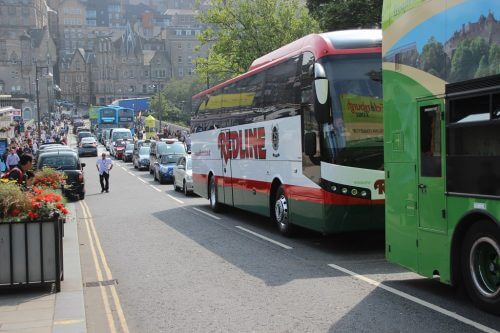
Darren Turpin, UK Marketing Manager at Trapeze Group, takes a look at where the UK transport industry is predicted to be in 2018, with help from some contributors
Where will the UK transport sector take us in 2018? This seemingly simple question is rather challenging to answer. A broad range of factors – including cultural, technological, legal and regulatory – are converging, creating a sector simultaneously rife with opportunity but also fraught with challenges.
Mobility as a Service (MaaS), availability of increasingly rich data, merging transport modes and even autonomous vehicles are driving some of the most dramatic changes our industry has ever seen. And yet these factors are balanced alongside the traditional and mundane: continued budgetary constraints and the endless quest for greater efficiency.
Our objective with this article is to ‘check the pulse’ on the UK transport industry by obtaining a broad perspective on where we are collectively headed. To that end we have reached out to a group of partners, colleagues and industry peers, asking them to consider the complex web of influences shaping our sector in order to answer the question, “what’s the biggest transit trend for 2018?”
The responses we received were wide ranging, fascinating and enlightening. We present them within this article, broadly grouped into factors driving the industry forward, and those challenges restricting change.
We thank our contributors for their efforts and hope you find their views as valuable as we do. Without further delay, here are our predictions for public transport in 2018 – and a little beyond.[wlm_nonmember][…]
By subscribing you will benefit from:
- Operator & Supplier Profiles
- Face-to-Face Interviews
- Lastest News
- Test Drives and Reviews
- Legal Updates
- Route Focus
- Industry Insider Opinions
- Passenger Perspective
- Vehicle Launches
- and much more!
Passenger demands and control
Social and cultural motivations are driving the industry forward at breakneck speed. Giles Bailey, Strategeeb Managing Director, transport columnist, strategist and former Head of Marketing Strategy at TfL predicts increasing consumer demand and mass-market appeal for a range of transport services, including ride hailing and free-floating cycle hire schemes. He points out that modern transport users expect flexibility and immediate availability, and that – in urban areas at least – the idea of waiting an indeterminate amount of time at a stop for a service that may never turn up is now long gone.
In a similar vein, Consultant Tim Rivett – formerly head of Information & Technology at SYPTE – notes that modern passengers have increasingly short attention spans, and that younger customers are more open to shared experiences. These cultural shifts will place new demands on how transport services are structured, feeding “increasingly polarised debate around the role of app-based transport services such as Uber versus midi (minibus scale) and mass public transport.”
Passenger control is a key theme noted by Jonathan Taylor, publisher of Coach & Bus Week, who suggests that the biggest trend in 2018 and onwards will be “that consumers, rather than transit providers, will drive how their trips run from A to B and via C if they so choose.” Jonathan predicts that transit providers will increasingly compete for the parts of consumers’ journeys that they can provide cost effectively for the consumer and profitably for their business.
Mobility as a Service
Passenger control over the forms of mobility inevitably leads us to the topic of MaaS. However, while many of our contributors see MaaS as a notable talking point, there is a reasonably common note of caution.
Tim Rivett summarises this view well: “MaaS will start to become part of this debate and conversations but frustratingly for the customer they are unlikely to see much or any change to services… The first services pretending to be MaaS services will start to become available though they are only likely to be aggregating multiple operators ticketing apps into single app/ticketing solutions.”

Urbanisation
Urbanisation is another common factor: Paul Everson, Product Manager at Trapeze, suggests that increasing urbanisation coupled with consumer demands for flexibility and visibility, will mean that bus operators and other transport organisations will need to meet the challenges of disruption head-on.
Rigid approaches to timetables and schedule design are unable to respond to day-to-day events, or offer the flexibility so many of our respondents referenced. “Technology integration is now removing silos that once existed,” Paul argues. “I think in 2018, bus operators’ operations teams will become more aware of their role in passenger information, using data standards to automatically pass information between departments.”
Giles Bailey also sees cities as an important factor, but notes that while they will drive innovation, they also desire “a sense of control of collective urban life as well as the effectiveness of public investment in transport that reflects the needs and politics of the city.” Innovation will therefore need to be integrated with urban planning and local policy.
Regulation
Regulation is of course another key driver of change. Peter Bell, Trapeze’s Chief Technology Officer, argues that the influence of the Buses Bill, signed into law in the UK in 2017, will be felt in two main ways: “Firstly, the Bill anticipates and requires the ability for operators to share information regarding fares – so expect to see greater focus on integrated ticketing across regions, likely moving towards a national EMV scheme.”
“Secondly, the Bill encourages use of Open Data as a way to entice start-up developers to enter the market. I expect we will see this type of information used to drive innovative new applications, including MaaS-type solutions offering integrated ticketing and journey planning.” In turn, these changes will create greater transparency and possibilities for innovation as a result of intelligent insights.
Autonomous – and beyond
The exciting growth in autonomous vehicles and the increasing electrification of transport – which, in turn, has powerful implications for automation and information-sharing systems – are referenced by Jonathan Taylor and Giles Bailey, as well as David Hytch, Director at Park Gate Consultants and former Information Systems Director at TfGM: “The growth in Connected and Autonomous vehicles, of all types and uses, continues apace. Transferring this to rail and light rail will become something we will see coming to the fore.”
David also sees artificial intelligence and virtual reality as factors: “Both of these technologies will also have an increasing impact on all other elements of transport, from customer information to ticketing and data analytics and operational management.”
Data
John Austin, Director at Austin Analytics, suggests that the positive trends of 2018 will “be principally around the manipulation of ‘big data’ and real-time data sets to offer public transport operators faster ways of responding to customer demands and market pressures and also better and more efficient ways of managing and operating their assets, including with the development of new forms of alternative fuels. The same trends in data management will also be reflected in the growth, albeit slowly, of ‘pop-up’ and semi-flexible operations not only in some interurban and intercity corridors but on a few urban ‘pilot’ routes where the legislation and local arrangements allow.”
Mike Schofield, formerly Managing Director, Intelligent Transport Systems at Atkins and now Director at Mike Schofield & Associates, sees similar importance here and foresees use of “technology and data as the engine room to match service provision to customer needs… deep understanding of customer expectations alongside traditional service operational excellence will enable new flexible service models to be developed and implemented.” To this end, Mike predicts that “capabilities within the transit industry will expand to cover high quality customer insight (perhaps from retail) and powerful data analytics.”

New procurement models
Speaking of data: Trapeze Business Unit Director, Kirsti Robinson, expects “collation of transport data from different modes to be used to provide passengers with greater choice and alternatives.” When considering Demand Responsive or Statutory Transport especially, we can expect to see “a shift towards a procurement model whereby Local Authorities become brokers of information and quality controllers, rather than transport providers.”
Congestion and environment
All the earlier opportunities do not come without challenges, however. John Austin comments on the ongoing challenge of congestion, worryingly speculating that “with a continuing paucity of major urban bus corridor infrastructure improvements being delivered, it is possible that alongside growth in urban rail (particularly as the first section of Crossrail is opened), the biggest transit trend in 2018 could be a continuation of the slowdown in bus journey speeds.”
Meanwhile, Giles Bailey, David Hytch and Tim Rivett all note broader challenges around environmental efficiency and restrictions on petrol and diesel engines; and the ongoing drive for cost-effectiveness, which will always be a top priority for all transport public sector organisations.
Ongoing budgetary constraints
Of the financial challenges, Tim Rivett offers a bleak outlook: “Public sector financial challenges will start to become much more evident in reducing service provision with more existing information services being reduced in scope or shut down to save money.”
Indeed, budgetary constraints remain very much part of the landscape for transport organisations in the public sector especially, as Kirsti Robinson underlines: “For organisations traditionally involved in delivery of Demand Responsive or Statutory Transport, integration with fixed services will offer passengers greater mobility and opportunities,” she says.
“This will simultaneously be driven by the impact of austerity on Local Authority budgets: as statutory and social funding become ever scarcer, the ability to feed passengers into mainstream routes will offer a precious means to increase patronage via corridors.”
Mike Schofield also predicts a continued pressure on transport budgets: “There will be relentless pressure to reduce the cost of traditional bus services, especially where these are at best marginally self-sustaining and rely on local authority support, and this will give rise to new approaches to service provision.”
However, returning to our earlier theme regarding data: Mike believes that enterprising local authorities will cope with these budget challenges by encouraging business model innovation through collaboration with third parties and improving service efficiency through the use of powerful data analytics.

Conclusion
Finding ways to balance the concerns outlined in this document alongside the ongoing drive for innovation seems set to be an important challenge for the UK public transport industry in 2018 – and indeed, balance is perhaps the key conclusion we can draw when considering what the global transit industry will truly look like in 2018 and beyond.
As our contributors have outlined, the future of our industry is rich with change and innovation – and it is worth noting that innovation can come in many forms and from different sources. It is particularly interesting to hear Giles Bailey’s predictions of mobility solutions from emerging economies: “There should be no assumptions that the flow of innovation can only be one way. The coming year will inevitably see more innovations that have been conceptualised, tested and perfected in other economies rapidly coming to other cities in a globalising world.”
But from wherever inspiration and innovation originate, none of us can ignore them. We must all find ways to negotiate this rapidly changing landscape, harnessing the opportunities and responding to the challenges in front of us.[/wlm_ismember]


